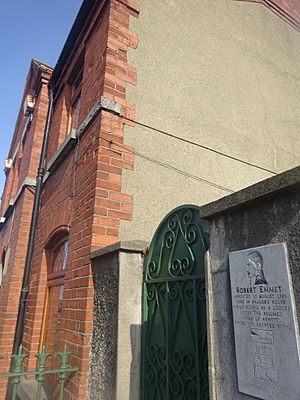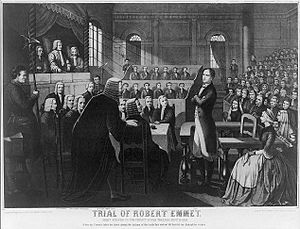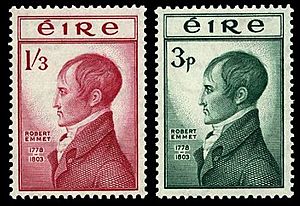Robert Emmet facts for kids
Quick facts for kids
Robert Emmet
|
|
|---|---|

A watercolour miniature of Emmet made during his trial.
|
|
| Born | 4 March 1778 Dublin, Ireland |
| Died | 20 September 1803 (aged 25) Dublin, Ireland |
| Allegiance | |
| Years of service | 1793–1803 |
| Rank | Commander |
| Commands held | Irish Rebellion of 1803 |
| Battles/wars | 1798 Rebellion Irish Rebellion of 1803 |
| Relations | Thomas Addis Emmet (brother) |
Robert Emmet (4 March 1778 – 20 September 1803) was an Irish leader and speaker. He wanted to change how Ireland was governed. After a big uprising in 1798, he tried to plan another one. His goal was to remove British rule and create a government for all Irish people.
Emmet hoped for help from France, but this did not happen. Many people who had fought in 1798 were unsure about joining him. His planned uprising in Dublin in 1803 did not go as planned. Even though his effort failed, Emmet's words and his brave end inspired many future Irish leaders. People like Patrick Pearse saw his attempt as a step towards Irish freedom.
Contents
Who Was Robert Emmet?
Emmet's Early Life and Family
Robert Emmet was born in Dublin on March 4, 1778. He was the youngest son of Dr. Robert Emmet, a doctor to the Lord Lieutenant of Ireland. His family was well-off and lived in a nice house in Dublin. They also had a country home.
His father supported American independence. Friends of the family included important figures like Theobald Wolfe Tone. Tone was a leader who wanted more fairness for all people in Ireland. Another family friend, Dr. William Drennan, helped start the group called the Society of United Irishmen.
Emmet's Time at College
Emmet started at Trinity College Dublin in 1793 when he was just 15. He was a very smart student, especially in history and chemistry. He joined the College Historical Society in 1797. This group was known for discussing important political ideas.
His older brother, Thomas Addis Emmet, and Wolfe Tone were also members. They often talked about "modern politics," even though the college did not want them to. Emmet was known for his amazing speaking skills. One friend, Thomas Moore, remembered how people would come just to hear Emmet speak. Emmet believed that if a government was not keeping up with its people, the people should make it change.
Emmet's Fight for Change
Becoming a Revolutionary Leader
In 1798, Emmet was found to be part of a secret college group. This group supported the Society of United Irishmen. Instead of answering questions that might get others in trouble, he left Trinity College.
Emmet did not take part in the 1798 uprising. But after it was put down, he helped rebuild the United Irish organization. He worked with William Putnam McCabe to make the group more like a military. They hoped to get France to invade Ireland again. They also wanted to work with other groups in Britain who wanted change.
Emmet went to Paris in 1800 to meet with Napoleon. He told Napoleon that the new union between Ireland and Britain had not made things better. He said the United Irishmen were ready to fight if France helped. However, Napoleon had other plans and did not send a large army.
Connecting with Other Groups
In 1802, Emmet returned to Dublin. He worked to prepare for another uprising. He also tried to connect with groups in England who wanted change. However, support in England was not as strong as he hoped.
When war with France started again in 1803, Emmet was not fully convinced that France would truly help Ireland. He believed France would mostly care about its own interests. He sent his own messenger to France asking for "money, arms, ammunition and officers," but not a large army. Emmet wanted Ireland to become independent mainly through the efforts of Irish people.
Planning the Dublin Uprising
After returning to Ireland in October 1802, Emmet began preparing for an uprising. He used money left to him by his father. On March 17, 1803, Emmet gave a powerful speech to his friends. He said that Ireland had even more reason to fight after the union with Britain. He believed that the union had taken away Ireland's ability to govern itself.
Emmet planned to attack Dublin Castle and take important officials hostage. This would signal the rest of the country to rise up. However, an accident happened on July 16. Gunpowder exploded at a rebel weapons storage place. This made the authorities suspicious. Emmet decided to start the uprising early, on July 23.
The Uprising Begins
On the morning of July 23, 1803, Emmet showed his men weapons like pikes and grenades. But there were not many firearms. Some men from Kildare were not impressed and left. The plan to surprise Dublin Castle failed when the rebels showed themselves too early.
By evening, Emmet and about 80 men were outside their weapons depot in Thomas Street, Dublin. Emmet saw a soldier being attacked and killed. He told his men to scatter. He had already called off other groups of rebels with a signal rocket.
Fighting continued in the city that night. The Lord Chief Justice of Ireland, Lord Kilwarden, was pulled from his carriage and killed. Emmet left the city and tried to prevent more violence. He sent Myles Byrne to Paris to try and get French help again.
Capture and Trial
Emmet hid in Rathfarnham. He wanted to say goodbye to his fiancée, Sarah Curran. If he had not, he might have escaped to France. But he was captured on August 25 and taken to prison.
Emmet was tried for a serious crime against the government on September 19. The evidence against him was very strong. Emmet chose not to defend himself or call any witnesses. He was sentenced to be executed.
On September 20, Emmet was executed in Thomas Street. No one came forward to claim his body because they were afraid of being arrested. Emmet had made a strong impression on officials, even those who had pursued him. One official, William Wickham, later said that if he had been Irish, he would have joined Emmet.
Where is Emmet Buried?
Emmet's body was first taken to Newgate Prison and then to Kilmainham Gaol. The jailer was told to bury him in a nearby hospital's burial ground if no one claimed him. Family stories say that in 1804, his remains were secretly moved. They were reburied in his family's vault at St. Peter's Church, Aungier Street, Dublin.
The poet Percy Bysshe Shelley later wrote about Emmet. He praised Emmet as a "patriot" who fought against a corrupt government. Shelley also advised the Irish people not to use violence to achieve their goals.
Robert Emmet's Legacy
Even though Emmet's rebellion failed, it showed that the union with Britain was not solving Ireland's problems. Some officials tried to play down the rebellion. They wanted it to seem like a small, unimportant event.
Later, leaders like Daniel O'Connell condemned Emmet's use of force. O'Connell believed in peaceful ways to achieve change. However, Emmet's reputation grew during the Famine years in the 1840s. Groups like the Young Irelanders admired him. They believed that if peaceful methods failed, fighting for freedom was honorable.
The Irish Republican Brotherhood (Fenians) also looked up to Emmet. His image even appeared on bonds they issued in the United States. Emmet's older brother, Thomas Addis Emmet, moved to the United States and became a lawyer. His family helped keep Robert's story alive among Irish people living abroad.
Before the Easter Rising in 1916, Patrick Pearse spoke about Emmet. He said that Emmet was a dreamer who became a man of action. He was a student who became a leader. Emmet was a man who loved peace but became a revolutionary. He never gave up on the idea of Irish freedom.
Honoring Robert Emmet
Many places in the United States are named after Robert Emmet. These include towns like Emmetsburg, Iowa, and counties like Emmet County, Michigan. A school in Chicago, Illinois, is also named after him.
Statues have been built to honor him:
- A bronze statue of Robert Emmet by Jerome Connor stands in St Stephen's Green, Dublin. This is near where Emmet was born. A copy of this statue is in Emmetsburg, Iowa.
- Another bronze statue by Jerome Connor is in Washington, D.C.
- A copy of this statue is also in Golden Gate Park in San Francisco.
- There is also a statue of Robert Emmet in the courthouse square in Emmetsburg, Iowa.
Images for kids
-
Bronze statue of Robert Emmet, 1916, by Jerome Connor, from the collection of the Smithsonian American Art Museum. It is installed in Washington, DC's Embassy Row.
-
Statue of Robert Emmet in St Stephens Green, Dublin
-
Reproduction of Robert Emmet statue in San Francisco's Golden Gate Park
See also
- Despard Plot
- Irish Rebellion of 1803
- John Allen
- Thomas Russell
- List of monuments and memorials to the Irish Rebellion of 1803








